Q1. A rectangular grassy lawn measuring 40 m by 25 m is to be surrounded externally by a path which is 2 m wide. Calcualte the cost of levelling the path at the rate of Rs. 8.25 per sq. metre.
Sol.

Length PQ = 40 m and breadth QR = 25 m
\begin{array}{l}\text {Area of grassy lawn PQRS }=40 \times 25 =1000 \text { m}^{2} \\ \text {Length AB } =40+2+2 \text { m} =44 \text { m} \\ \text {Breadth BC }=25+2+2 \text { m}=29 \text { m} \\ \text {Area of rectangle area ABCD} =44 \times 29 =1276 \text { m}^{2} \\ \text {Area of the path } = \text {Area of ABCD } – \text {Area of grassy lawn PQRS } = 1276 – 1000 =276 \text { m}^{2} \\ \text {Rate of levelling the path } = \text {Rs .} 8.25 \text { per } \text { m}^{2} \\ \therefore \text {Cost of levelling the path }= \text {Rs. } 8.25 \times 276 = \text {Rs. } 2277 \\\end{array}Q2. One metre wide path is built inside a square park of side 30 m along its sides. The remaining part of the park is covered by grass. If the total cost of covering by grass is Rs. 1176, find the rate per square metre at which the park is covered by the grass.
Sol.

Given that side of square garden = 30 m.
\begin{array}{l}\text {Area of the square garden including the path }=(30)^{2}=900 \text { m}^{2} \\ \text {Given that width of path build inside the park} = 1 \text { m} \\ \therefore \text {Side of the square garden, without path } = 30-1-1 = 28 \text { m} \\ \text {Area of the square garden , without path } =(28)^{2}=784 \text { m}^{2} \\ \text {Total cost of covering the park with grass } \\ = \text {Area of the park covered with grass} \times \text {Rate per square metre for grassing} \\ \Rightarrow \quad 1176=784 \times \text {Rate per square metre for grassing } \\ \Rightarrow \quad \text {Rate per square metre for grassing } =\text {Rs. } \frac {1176}{784} =\text {Rs. } 1.50\end{array}Q3. Through a rectangular field of sides 90 m × 60 m, two roads are constructed which are parallel to the sides and cut each other at right angles through the centre of the field. If the width of the roads is 3 m, find the total area covered by the two roads.
Sol.

Length of the rectangular field = 90 m.
Breadth of the rectangular field = 60 m.
\begin{array}{l} \text {Area of the rectangular field }=90 \text { m} \times 60 \text { m}=5400 \text { m}^{2} \\ \text {Area of the road EFGH}=90 \text { m} \times 3 \text { m}=270 \text { m}^{2} \\ \text {Area of the road PQRS}=60 \text { m} \times 3 \text { m}=180 \text { m}^{2} \\\text {Area of IJKL}=3 \text { m} \times 3 \text { m}=9 \text { m}^{2} \\ \text {Clearly, area of IJKL is common in two roads.} \\ \text {Hence, combined area covered by two roads } \\ = \text {Area of EFGH} + \text {Area of PQRS} – \text {Area of IJKL} \\ =270 + 180 -9 =441 \text { m}^{2} \end{array}Q4. From a rectangular sheet of tin, of size 100 cm by 80 cm, are cut four squares of side 10 cm from each corner. Find the area of the remaining sheet.
Sol.

Length of the rectangular sheet = 100 cm.
Breadth of the rectangular sheet = 80 cm.\begin{array}{l} \text {Area of the rectangular sheet of tin}=100 \times 80 =8000 \text { cm}^{2} \\\text {Side of the square at the corner of the sheet } =10 \text { cm} \\ \text {Area of one square at the corner of the sheet } =(10)^{2}=100 \text { cm}^{2} \\ \text {Area of 4 squares at the corner of the sheet }=4 \times 100 =400 \text { cm}^{2} \\ \text {Hence, area of the remaining sheet of tin } \\ = \text {Area of the rectangular sheet of tin } – \text {Area of the 4 squares at the corners } \\ =8000-400=7600 \text { cm}^{2}\end{array}Q5. A painting 8 cm long and 5 cm wide is painted, on a cardboard such that there is a margin of 1.5 cm along each of its sides. Find the total area of the margin.
Sol.

Length of the cardboard = 8 cm.
And breadth of the cardboard = 5 cm.\begin{array}{l}\text {Area of the cardboard including the margin } =8 \times 5 =40 \text { cm}^{2} \\ \text {Length of the painting without margin }=8-1.5-1.5 =5 \text { cm} \\ \text {Breadth of the painting without margin }=5-1.5-1.5 =2 \text { cm} \\\text {Area of the painting without margin }=5 \times 2 =10 \text { cm}^{2} \\ \text {Hence, area of the margin } \\ = \text {Area of the full cardboard } – \text {Area of the painting without margin} \\ =40-10=30 \text { cm}^{2} \end{array}Q6. Rakesh has a rectangular field of length 80 m and breadth 60 m. In it, he wants to make a garden 10 m long and 4 m broad at one of the corners and at another corner, he wants to grow flowers in two floor-beds each of size 4 m by 1.5 m. In the remaining part of the field, he wants to apply manures. Find the cost of applying the manures at the rate of Rs 300 per acre.
Sol.

Length of the rectangular field = 80 m.
Breadth of the rectangular field =60 m.
\begin{array}{l} \text {Area of the rectangular field }=80 \times 60=4800 \text { m}^{2} \\ \text {Area of the garden }=10 \times 4=40 \text { m}^{2} \\\text {Area of one flower bed }=4 \times 1.5 =6 \text { m}^{2} \\\text {Area of two flower beds }=2 \times 6 =12 \text { m}^{2} \\ \text {Area of the field left for manuring} \\ = \text {Total Area of the field} – \text {Area of the garden} – \text {Area of the two flower beds} \\ =4800 -40 – 12 =4800-52 =4748 \text { m}^{2} \\=4748 \times \frac {1}{100} \text { acre} \quad [\because 100 \text { m}^{2} =1 \text { acre}] \\ =47.48 \text { acres } \\\end{array} Therefore, Cost of applying manure at the rate of Rs. 300 per acre = 300 × 47.48 = Rs. 14244.
Q7. Each side of a square flower bed is 2 m 80 cm long. It is extended by digging a strip 30 cm wide all around it. Find the area of the enlarged flower bed and also the increase in the area of the flower bed.
Sol.

\begin{array}{l} \text {Side of the flower bed } =2 \text { m } 80 \text {cm}=280 \text { cm} \quad [\because 1 \text { m } = 100 \text { cm}] \\\text {Area of the square flower bed }=(280)^{2}=78400 \text { cm}^{2} \\ \text {Side of the flower bed with 30 cm strip around it }=280 +30 +30 = 340 \text { cm} \\ \text {Area of the enlarged flower bed with strip }=(340)^{2} = =115600 \text { cm}^{2} \\\therefore \text {Increased area of the flower bed } \\ = \text {Area of the enlarged flower bed with strip} – \text {Area of the square flower bed} \\ =115600 -78400 \text { cm}^{2} \\ =37200 \text { cm}^{2} \\ =3.72 \times \frac {1}{10000} \text { m}^{2} \quad [\because 1 \text { cm}^{2} = \frac {1}{10000} \text { m}^{2}] \\ =3.72 \text { m}^{2} \\ \end{array}Q8. A room 5 m long and 4 m wide is surrounded by a verandah. If the verandah occupies an area of 22 sq metre, find the width of the varandah.
Sol.

Lets assume that the width of the verandah be x m.
Given that length of the room = 5 m.
And breadth of the room = 4 m.
\begin{array}{l}\text {Area of room } =\text {Length} \times \text {Breadth} \\ =5 \times 4 =20 \text { m}^{2} \\\text {Length of the veranda }=5+x+x=(5+2 x) \text { m} \\ \text {Breadth of the veranda }=4+x+x=(4+2 x) \text { m} \\ \text {Total area of room plus veranda } =(5+2 x) \times (4+2 x) = (4x^{2} + 18x + 20) \text { m}^{2} \\ \text {Area of veranda} = \text {Total Area} – \text {Area of room} \\ \Rightarrow \quad 22 =(4x^{2} + 18x + 20) -20 \\ \Rightarrow \quad 22=4 x^{2}+18 x \\ \Rightarrow \quad 11=2 x^{2}+9 x \\ \Rightarrow \quad 2 x^{2}+9 x -11 = 0\\ \Rightarrow \quad 2 x^{2}+11 x-2 x-11=0 \\ \Rightarrow \quad x(2 x+11)-1(2 x+11)=0 \\ \Rightarrow \quad (x-1)(2 x+11)=0 \\ \text {When } x-1=0 \quad \Rightarrow \quad x=1 \\ \text {When } 2 x+11=0 \quad \Rightarrow \quad x=-\frac {11}{2} \\ \because \text {Width cannot be a negative, so width of the veranda is 1 m} \\ \end{array}
Sol.
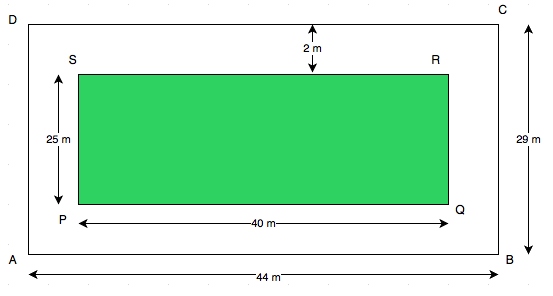
Length PQ = 40 m and breadth QR = 25 m
\begin{array}{l}\text {Area of grassy lawn PQRS }=40 \times 25 =1000 \text { m}^{2} \\ \text {Length AB } =40+2+2 \text { m} =44 \text { m} \\ \text {Breadth BC }=25+2+2 \text { m}=29 \text { m} \\ \text {Area of rectangle area ABCD} =44 \times 29 =1276 \text { m}^{2} \\ \text {Area of the path } = \text {Area of ABCD } – \text {Area of grassy lawn PQRS } = 1276 – 1000 =276 \text { m}^{2} \\ \text {Rate of levelling the path } = \text {Rs .} 8.25 \text { per } \text { m}^{2} \\ \therefore \text {Cost of levelling the path }= \text {Rs. } 8.25 \times 276 = \text {Rs. } 2277 \\\end{array}Q2. One metre wide path is built inside a square park of side 30 m along its sides. The remaining part of the park is covered by grass. If the total cost of covering by grass is Rs. 1176, find the rate per square metre at which the park is covered by the grass.
Sol.
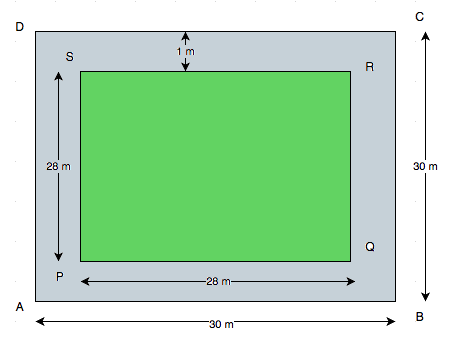
Given that side of square garden = 30 m.
\begin{array}{l}\text {Area of the square garden including the path }=(30)^{2}=900 \text { m}^{2} \\ \text {Given that width of path build inside the park} = 1 \text { m} \\ \therefore \text {Side of the square garden, without path } = 30-1-1 = 28 \text { m} \\ \text {Area of the square garden , without path } =(28)^{2}=784 \text { m}^{2} \\ \text {Total cost of covering the park with grass } \\ = \text {Area of the park covered with grass} \times \text {Rate per square metre for grassing} \\ \Rightarrow \quad 1176=784 \times \text {Rate per square metre for grassing } \\ \Rightarrow \quad \text {Rate per square metre for grassing } =\text {Rs. } \frac {1176}{784} =\text {Rs. } 1.50\end{array}Q3. Through a rectangular field of sides 90 m × 60 m, two roads are constructed which are parallel to the sides and cut each other at right angles through the centre of the field. If the width of the roads is 3 m, find the total area covered by the two roads.
Sol.
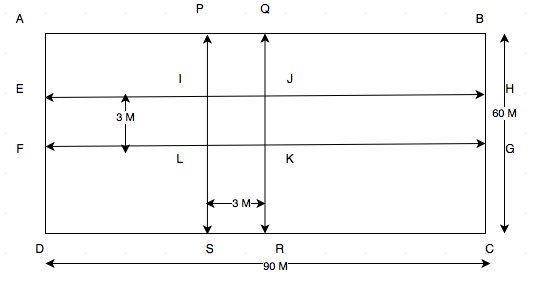
Length of the rectangular field = 90 m.
Breadth of the rectangular field = 60 m.
\begin{array}{l} \text {Area of the rectangular field }=90 \text { m} \times 60 \text { m}=5400 \text { m}^{2} \\ \text {Area of the road EFGH}=90 \text { m} \times 3 \text { m}=270 \text { m}^{2} \\ \text {Area of the road PQRS}=60 \text { m} \times 3 \text { m}=180 \text { m}^{2} \\\text {Area of IJKL}=3 \text { m} \times 3 \text { m}=9 \text { m}^{2} \\ \text {Clearly, area of IJKL is common in two roads.} \\ \text {Hence, combined area covered by two roads } \\ = \text {Area of EFGH} + \text {Area of PQRS} – \text {Area of IJKL} \\ =270 + 180 -9 =441 \text { m}^{2} \end{array}Q4. From a rectangular sheet of tin, of size 100 cm by 80 cm, are cut four squares of side 10 cm from each corner. Find the area of the remaining sheet.
Sol.
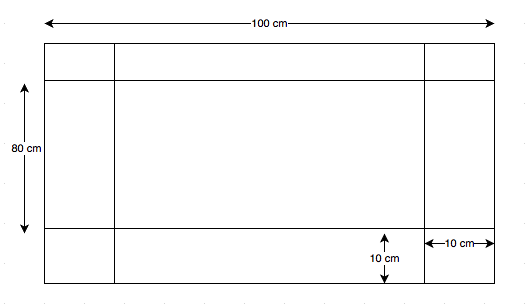
Length of the rectangular sheet = 100 cm.
Breadth of the rectangular sheet = 80 cm.\begin{array}{l} \text {Area of the rectangular sheet of tin}=100 \times 80 =8000 \text { cm}^{2} \\\text {Side of the square at the corner of the sheet } =10 \text { cm} \\ \text {Area of one square at the corner of the sheet } =(10)^{2}=100 \text { cm}^{2} \\ \text {Area of 4 squares at the corner of the sheet }=4 \times 100 =400 \text { cm}^{2} \\ \text {Hence, area of the remaining sheet of tin } \\ = \text {Area of the rectangular sheet of tin } – \text {Area of the 4 squares at the corners } \\ =8000-400=7600 \text { cm}^{2}\end{array}Q5. A painting 8 cm long and 5 cm wide is painted, on a cardboard such that there is a margin of 1.5 cm along each of its sides. Find the total area of the margin.
Sol.
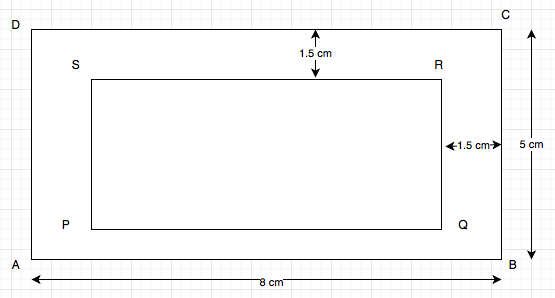
Length of the cardboard = 8 cm.
And breadth of the cardboard = 5 cm.\begin{array}{l}\text {Area of the cardboard including the margin } =8 \times 5 =40 \text { cm}^{2} \\ \text {Length of the painting without margin }=8-1.5-1.5 =5 \text { cm} \\ \text {Breadth of the painting without margin }=5-1.5-1.5 =2 \text { cm} \\\text {Area of the painting without margin }=5 \times 2 =10 \text { cm}^{2} \\ \text {Hence, area of the margin } \\ = \text {Area of the full cardboard } – \text {Area of the painting without margin} \\ =40-10=30 \text { cm}^{2} \end{array}Q6. Rakesh has a rectangular field of length 80 m and breadth 60 m. In it, he wants to make a garden 10 m long and 4 m broad at one of the corners and at another corner, he wants to grow flowers in two floor-beds each of size 4 m by 1.5 m. In the remaining part of the field, he wants to apply manures. Find the cost of applying the manures at the rate of Rs 300 per acre.
Sol.

Length of the rectangular field = 80 m.
Breadth of the rectangular field =60 m.
\begin{array}{l} \text {Area of the rectangular field }=80 \times 60=4800 \text { m}^{2} \\ \text {Area of the garden }=10 \times 4=40 \text { m}^{2} \\\text {Area of one flower bed }=4 \times 1.5 =6 \text { m}^{2} \\\text {Area of two flower beds }=2 \times 6 =12 \text { m}^{2} \\ \text {Area of the field left for manuring} \\ = \text {Total Area of the field} – \text {Area of the garden} – \text {Area of the two flower beds} \\ =4800 -40 – 12 =4800-52 =4748 \text { m}^{2} \\=4748 \times \frac {1}{100} \text { acre} \quad [\because 100 \text { m}^{2} =1 \text { acre}] \\ =47.48 \text { acres } \\\end{array} Therefore, Cost of applying manure at the rate of Rs. 300 per acre = 300 × 47.48 = Rs. 14244.
Q7. Each side of a square flower bed is 2 m 80 cm long. It is extended by digging a strip 30 cm wide all around it. Find the area of the enlarged flower bed and also the increase in the area of the flower bed.
Sol.
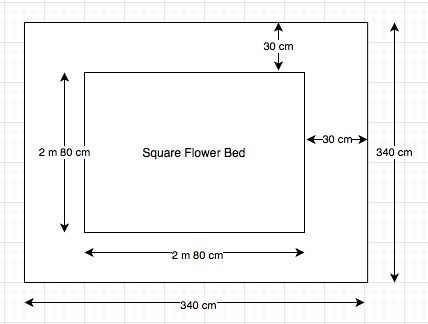
\begin{array}{l} \text {Side of the flower bed } =2 \text { m } 80 \text {cm}=280 \text { cm} \quad [\because 1 \text { m } = 100 \text { cm}] \\\text {Area of the square flower bed }=(280)^{2}=78400 \text { cm}^{2} \\ \text {Side of the flower bed with 30 cm strip around it }=280 +30 +30 = 340 \text { cm} \\ \text {Area of the enlarged flower bed with strip }=(340)^{2} = =115600 \text { cm}^{2} \\\therefore \text {Increased area of the flower bed } \\ = \text {Area of the enlarged flower bed with strip} – \text {Area of the square flower bed} \\ =115600 -78400 \text { cm}^{2} \\ =37200 \text { cm}^{2} \\ =3.72 \times \frac {1}{10000} \text { m}^{2} \quad [\because 1 \text { cm}^{2} = \frac {1}{10000} \text { m}^{2}] \\ =3.72 \text { m}^{2} \\ \end{array}Q8. A room 5 m long and 4 m wide is surrounded by a verandah. If the verandah occupies an area of 22 sq metre, find the width of the varandah.
Sol.

Lets assume that the width of the verandah be x m.
Given that length of the room = 5 m.
And breadth of the room = 4 m.
\begin{array}{l}\text {Area of room } =\text {Length} \times \text {Breadth} \\ =5 \times 4 =20 \text { m}^{2} \\\text {Length of the veranda }=5+x+x=(5+2 x) \text { m} \\ \text {Breadth of the veranda }=4+x+x=(4+2 x) \text { m} \\ \text {Total area of room plus veranda } =(5+2 x) \times (4+2 x) = (4x^{2} + 18x + 20) \text { m}^{2} \\ \text {Area of veranda} = \text {Total Area} – \text {Area of room} \\ \Rightarrow \quad 22 =(4x^{2} + 18x + 20) -20 \\ \Rightarrow \quad 22=4 x^{2}+18 x \\ \Rightarrow \quad 11=2 x^{2}+9 x \\ \Rightarrow \quad 2 x^{2}+9 x -11 = 0\\ \Rightarrow \quad 2 x^{2}+11 x-2 x-11=0 \\ \Rightarrow \quad x(2 x+11)-1(2 x+11)=0 \\ \Rightarrow \quad (x-1)(2 x+11)=0 \\ \text {When } x-1=0 \quad \Rightarrow \quad x=1 \\ \text {When } 2 x+11=0 \quad \Rightarrow \quad x=-\frac {11}{2} \\ \because \text {Width cannot be a negative, so width of the veranda is 1 m} \\ \end{array}
